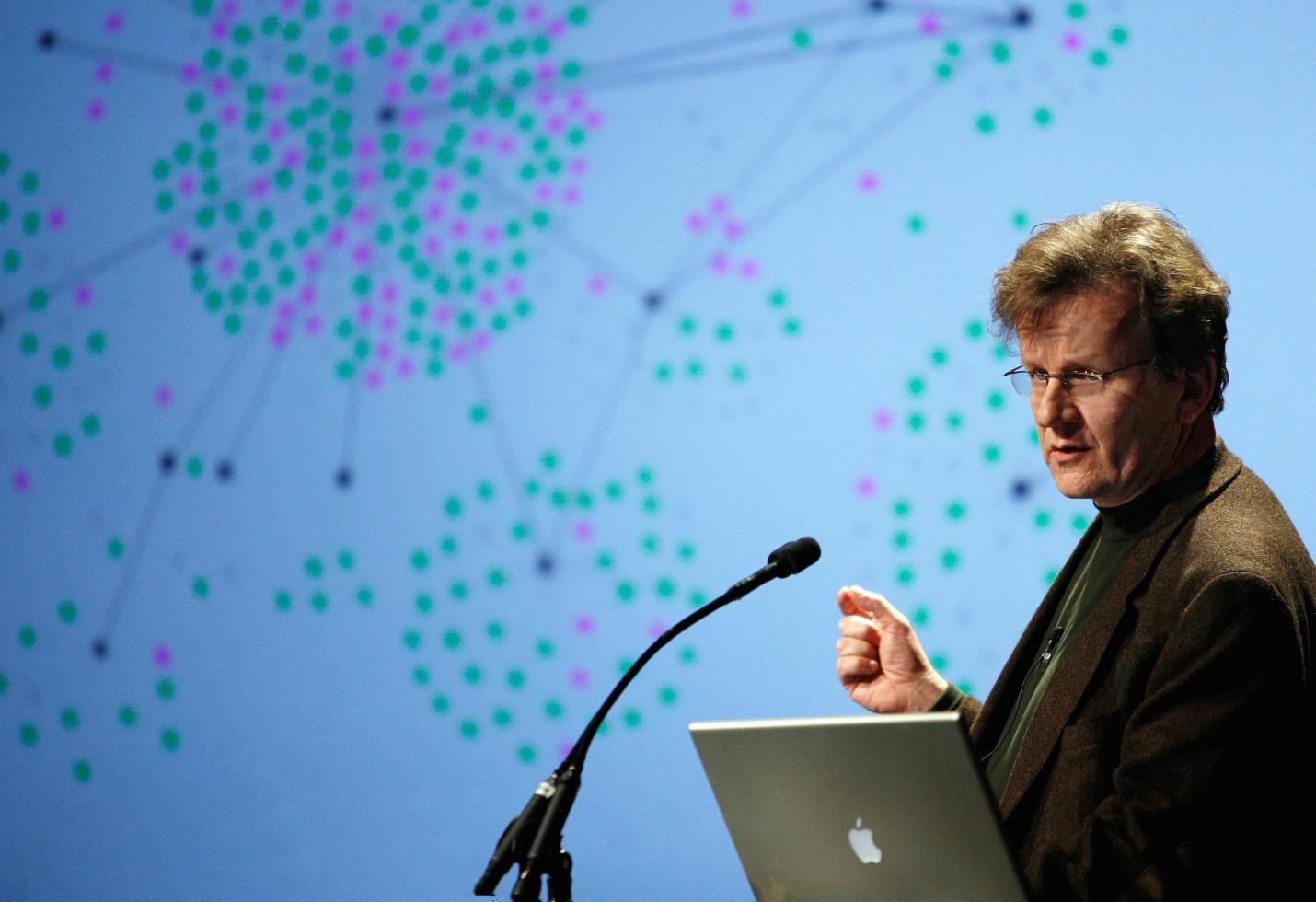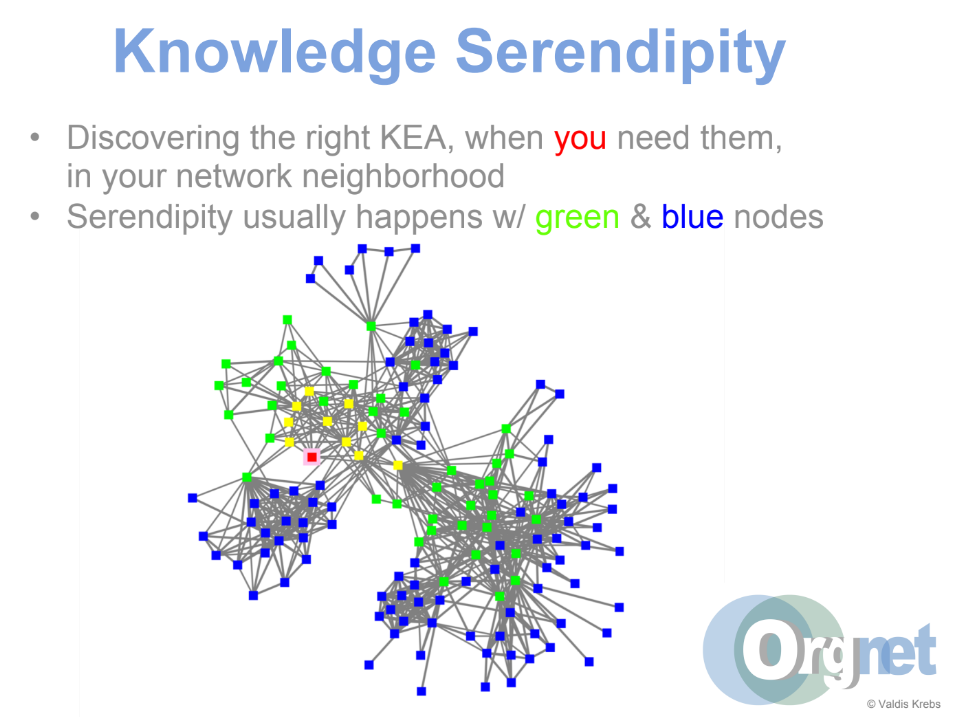9th Annual Midwest KM Symposium: Part 3 – Valdis Krebs

Stan Garfield
This is the third in a series of posts about the Midwest Knowledge Management Symposium held June 16, 2023 at Kent State University. This post is about the first presentation in Track 1 (People and Processes) delivered by Valdis Krebs, who was presenting at his third Midwest KM Symposium.

Valdis is a data scientist who specializes in social, relational, data analysis and visualization to help clients understand our organizations and communities in a world of complex/entangled knowledge flows, human interactions, exchanges, and influence.
He is a network scientist, who uses data mining, social network analysis, pattern discovery and artificial intelligence (AI) to assist a worldwide client base. He developed the popular InFlow software and many other unique algorithms for discovering patterns in human networks.
Before starting his own business, Valdis held various HR management positions at The Walt Disney Company, TRW Space & Defense, Ford Motor Company, and Toyota USA. Valdis works from his office in Cleveland, Ohio with a network of colleagues and collaborators around the world.
Valdis has been cited thousands of times in academic publications, patent applications and court documents on network analysis, network visualization, organizational networks, community networks, and covert/criminal networks. His work also appears in dozens of business books.
Knowledge Serendipity – Networks, Conversations, and Interactions presented by Valdis Krebs
Valdis started by defining Social Network Analysis (SNA) as the mapping and measuring of relationships, interactions, and flows between people, groups, organizations, computers, and other connected information/knowledge processing entities. The nodes in the network are people and groups while links show relationships, flows and interactions between nodes. SNA provides both a visual and a mathematical analysis of how complex human systems work
He then asked what leads to organizational success. “Is it who you know, or what (KEA: Knowledge, Experiences, Abilities) you know?”
His answered the question as follows:
“It’s who you know + what you know”
AND
It’s who you know that knows what!
AND
It’s who you know that knows who that knows what!
Valdis suggested that those who are one, two, or three steps away from you comprise your network neighborhood, and that those who are four, five, or six steps away don’t matter. Serendipity usually happens with those in the green and blue nodes as pictured here:

He explained that Measuring Organizational Diversity (MOD) slowly morphed into mapping and measuring organizational knowledge sharing. He went on to offer examples, including a corporate project problem, a non-profit strategy problem, a corporate strategy problem (the Apple iPod), and how COVID-19 drove drug discovery.
Unfortunately, Valdis ran out of time before he could present his conclusions from the stories he told. However, this provides me an opportunity to offer them here.
What needed to come together?
- Innovation is usually a new mix of what we already know and what we don’t know – yet.
- Knowledge and ideas are not all in the right place at the right time, or stored in a database, waiting for innovation to happen.
- Different people from different disciplines need to discuss ideas and knowledge from their diverse perspectives. Connect on your similarities and benefit from your differences.
- Most successful teams in research and business have a mixture of people that have experience with each other, and new members to the team. Too much similarity, or too much difference never succeeds as well as the right mix of both.
- Prior successful experiences and trusted collaborators get reused in new projects of similar, yet different needs.
Lessons Learned
- You never know what knowledge you will need until you need it
- Knowledge does not arrive pre-packaged, ready for use. Context is key, it determines what ideas and knowledge are involved and who is involved to make sense of what is happening and what may be
- Connections matter! Often the non-obvious ties in our networks are key
- knowledge holders, sense-makers. Their experience is necessary to work our current context.
- Sometimes we forget our ideas, or even what we know. Someone in our network re-ignites those dormant thoughts and helps us piece them together. What is necessary bubbles to the surface, when it is needed.
- Can’t predict the future, but you can prepare for it!
Network Lessons
- Never lose a good tie; stay connected, even if they are far away. Distance can create opportunities!
- Serendipity usually happens in your 2 & 3 step network neighborhood
- Need both similarity and difference
- But not too much of either
- Your network must be a good combination of Reach and Redundancy

The final slide in Valdis’s presentation contained this quote:
- “What makes societies work are the interactions among us” – Albert-Lászlo Barabási
After the symposium I asked Valdis if he would like the chance to present the full talk on a future SIKM Leaders Community call. He agreed and is currently scheduled for a year from now on July 16, 2024, although this might change if an earlier slot opens. For more about Valdis Krebs and his work, see my Profile in Knowledge.
Part 4 of this series will feature Dan Ranta. Part 2 featured Zach Wahl.

Stan Garfield
Please enjoy Stan’s blog posts offering advice and insights drawn from many years as a KM practitioner. You may also want to download a free copy of his book, Lucidea’s Lens: Special Librarians & Information Specialists; The Five Cs of KM from Lucidea Press, and its precursor, Proven Practices for Implementing a Knowledge Management Program. Learn about Lucidea’s Presto, SydneyEnterprise, and GeniePlus software with unrivaled KM capabilities that enable successful knowledge curation and sharing.
Never miss another post. Subscribe today!
Similar Posts
Lucidea’s Lens: Knowledge Management Thought Leaders Part 98 – Rachad Najjar
Generative AI, expertise mapping, and knowledge sharing—Rachad Najjar has spent his career at the intersection of these disciplines. As the CEO of 3R Knowledge Services and former knowledge-sharing leader at GE Vernova, he has helped many organizations design smarter KM strategies. In this edition of Lucidea’s Lens, Stan Garfield highlights Rachad’s contributions to the field.
Lucidea’s Lens: Knowledge Management Thought Leaders Part 97 – Art Murray
As CEO of Applied Knowledge Sciences and Chief Fellow of the Enterprise of the Future Program, Art Murray champions innovative approaches to knowledge curation, digital transformation, and governance. Discover Art’s work and impact on knowledge management and organizational transformation.
Lucidea’s Lens: Knowledge Management Thought Leaders Part 96 – Peter Morville
Peter Morville is a pioneer in the fields of information architecture and user experience, with expertise in organizational strategy and planning. His specialties include findability, information architecture, user experience, usability, and systems thinking.
Lucidea’s Lens: Knowledge Management Thought Leaders Part 95 – Matt Moore
Matt Moore is a project/program manager, blogger, presenter, webinar host, and deep thinker. He has worked in the knowledge management field for over 20 years.




Leave a Comment
Comments are reviewed and must adhere to our comments policy.
0 Comments